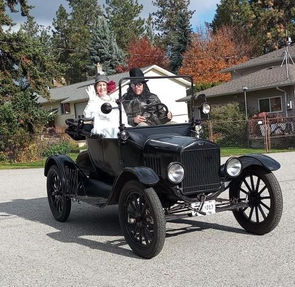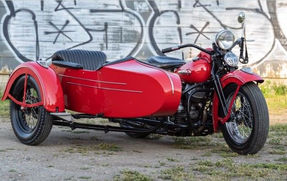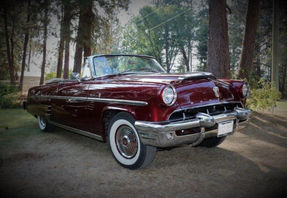Member's Vehicles
As one browses through the following collection of Kelowna Classics member's cars, one can't help but reminisce about the "good old days". Car photographs taken by a variety of VCCC members.
Thanks to '100 Years of the American Auto - Millennium Edition' by James M. Flamming and the Auto Editors of Consumer Guide. Published in 1999 by Publications International, Ltd for information gleaned to enhance our collection of TIN.
Quick navigation through the eras:
1903-1919 / 1920-1929 / 1930-1941
1942-1945 / 1946-1948 / 1949 / 1950-1952
1953-1959 / 1960-1971 / 1972-1979 / 1980-1990
UP and RUNNING: 1903 - 1919
Taking a spin in this era car wasn't exactly easy. Gearboxes were bulky; steering required muscles. Drivers had to manage hand throttles, spark levers, drip-oilers - each a task in itself. Carbide and kerosene lamps gave poor illumination at night.
Some of the automobiles built during this period include: A.B.C. High-Wheeler; American (Underslung); Austin; Blackhawk; Buckmobile; Buick; Cadillac; Chevrolet; Cincinnati Steam; Columbus Electric; Eagle Air Cooled; Ford; Franklin; Graham Electric; Hudson; Kissel; Marble-Swift; Maxwell; Oldsmobile; Overland; Packard; Rambler; Studebaker; Willis-Knights; just to name a few.

ANYTHING GOES: 1920 - 1929
Automotive technology was moving forward. Closed bodies were displacing the open roadster and touring cars, using less wood and more steel. Hydraulic brakes began to replace mechanical units, stopping four wheels instead of two. The introduction of synchromesh soon made gear clashing a distant memory. Driving was becoming easier and safer.
Production figures for the top 8 in 1929 were:
(1) Ford 1,507,132; (2) Chevrolet 1,328,605; (3) Hudson/Essex 300,962; (4) Willys-Overland/Whippet 242,000;
(5) Pontiac/Overland; 211,054; (6) Buick 196,104; (7) Dodge 124,557; (8) Nash 116,622

SURVIVAL of the FITTEST: 1930 - 1941
During this era, the number of significant car makers slimmed from about 60 in 1929 to 18 in 1941. A brief stab at minicars started with the American Austin and its Bantam successor; later called the Crosley. Paved roads more than doubled in a decade (USA), as the automobile culture grew. Drive-ins lured moviegoers and tourist courts dotted the landscape. At the New York World's Fair of 1939, GM's Futurama predicted the world of the Sixties, including 100 mph superhighways. The modern age was imminent, but North America had to face another world war before enjoying all its fruits.

DETROIT GOES TO WAR: 1942 - 1945
"Blackout" 1942 automobiles - those produced after January 1 - get government-ordered painted parts instead of chrome trim: most cars look lower, longer, and more massive.
The end of hostilities found many Americans with stuffed wallets from war-time work, and hungry for civilian products - especially automobiles they'd been deprived of. Postwar would be a new world.
POSTWAR "SELLER'S MARKET": 1946 - 1948
With pockets stuffed with money , car-starved American's eagerly snapped up the warmed-over '42s as they slowly began to trickle off Detroit's assembly lines.

A NEW ERA BEGINS: 1949
Industry production hits a record high 6,253,651 vehicles rolling off American assembly lines. All Big Three makes display modern postwar styling, two years after Studebaker's "radical" totally new redesign. New-car prices continue their postwar upward spiral.

"BUYER'S MARKET" RETURNS: 1950 - 1952
The American auto industry might have been expected to pause after its frantic product pace of 1948-1949, and it did. Yet there was still plenty to keep buyers interested in 1950-1952.
1950 Model Year USA Production figures include:
(1) Chevrolet - 1,498,590; (2) Ford - 1,208,912; (3) Plymouth - 610,954; (4) Buick - 588,439; (6) Pontiac - 446,429; (7) Oldsmobile - 408,060; (7) Dodge - 341,797; (8) Studebaker - 320,884; (9) Mercury - 293,658; (10) Chrysler - 179,299; (11) Nash - 171,782; (12) DeSoto - 136,203; (13) Hudson - 121,408; (14) Cadillac - 103,857; (15) Packard - 42,627; (16) Lincoln - 28,190; (17) Kaiser - 15,228; (18) Crosley - 6,792; (19) Frazer - 3,700.

The DESIGNER is KING: 1953 - 1959
Detroit reflected the American national bent for good times and free spending by spewing forth a dazzling array of cars. Each yearly crop was seemingly more colourful, complex, and contrived than the last - as well as longer, lower, wider, heavier, and more powerful. Alas, there were fewer makes to chose from by decade's end. Throughout these years, Detroit waged a "horsepower race". Sadly, handling and braking were anything but ideal (ditto for fuel efficiency - gas was around a quarter a gallon), yet a few automakers timidly tried selling safety features like seat belts and padded dashboards.

DETROIT THINKS small & MUSCLE CARS: 1960 - 1971
Suddenly it was 1960, and the times began changing as never before. Cold War, possible nuclear Armageddon, and the beginning of Civil Rights, and the space program has finally gotten off the ground. Compact cars may have been on Detroit's collective minds, but performance was still closest to the heart. The Fifties "horsepower race" had not really abated - it had merely gone underground with the June 1957 manufacturers' agreement to abandon racing and performance advertising. In 1961, however, the race came aboveground when Chevrolet unleashed its "real fine" 409 big-block V-8, along with a sporty new big car, the Impala SS. Ford replied for '62 with a burly 406, and Chrysler kept pace with a husky 413 wedge-head. At the performance pinnacle in these years were two 1963 stunners, Studebaker's singular (and unexpected) Avanti and the first all-new Corvette since 1953, the Sting Ray.

GOVERNMENT STEPS IN: 1972 - 1979
The United States Congress had long since decided to make automakers answer for the social responsibility of their products, and the legislative hand became increasingly heavier in these years. The Clean Air Act of 1970 mandated ever-tighter limits on exhaust emissions that sapped horsepower; combined with soaring insurance premiums, they all but eliminated performance cars by 1973. That same year brought more required safety features, including bumpers able to endure five-mph impacts without damage, plus the diabolical ignition interlocks that prevented starting up unless the front-seat occupants were buckled up. The latter proved so irksome that the public got it repealed after a single year.

CUTBACKS AND CONFUSION: 1980 - 1990
Ford emerged as Detroit's big Eighties winner, with strong sellers like Taurus and the most cost-effective manufacturing operation around. Significantly, Ford became America's most profitable automaker in 1986, out-earning giant GM for the first time in 42 years. That remarkable achievement only underscored how GM had delayed making the kind of wrenching, fundamental changes demanded by the new world automotive order. The CAFE requirements rises to 20 mpg; automakers cut weights, adopt smaller engines, improve aerodynamics and push diesels.


























































































